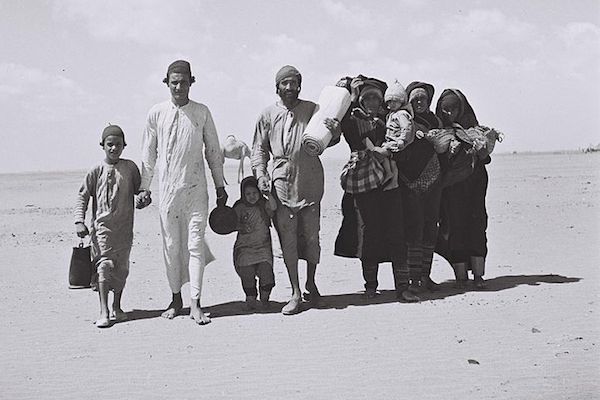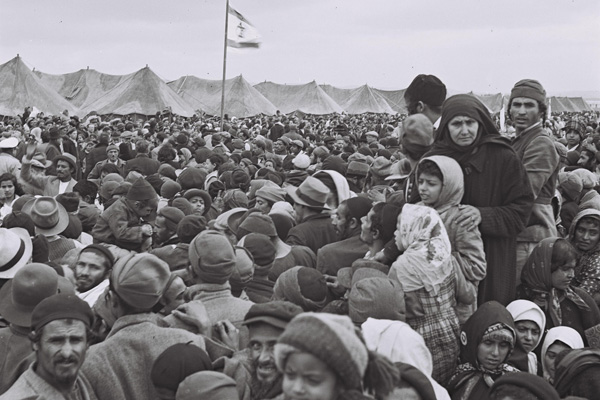A controversial new television show gives us a glimpse into Jewish-Muslim relations before Israel’s establishment, as well as a better understanding of those Jews who left Arab countries only to become Israel’s Mizrahim.
By Nadia Naser-Najjab
A recent controversy over a new Egyptian television series has served to highlight one of the central tensions at the heart of Zionist thought. This controversy has arisen in relation to “Haret al-Yahud” (“The Jewish Quarter”), a love story which depicts a romantic relationship between a male Egyptian-Muslim army officer (Iyad Nassar) and a female Egyptian-Jewish character (Mena Shalaby). The series, which is being broadcast during the month of Ramadan, has attracted both local and international media attention.
The Israeli embassy in Cairo approvingly observed that the series, which is set in a mixed and multicultural neighborhood of Cairo—and which develops over the period 1948-1954—has broken with the established conventions of the Israeli-Arab conflict and portrays Jews as “human beings.” Nonetheless, after this initially positive appraisal, the series failed to sustain the embassy’s approval, and it subsequently expressed its disapproval of the implication that the foundation of the Israeli state established the basis for many of the hatreds and mutual misunderstandings between Israelis and their Arab neighbors.
Although the series is undoubtedly interesting in its own right, my interest was primarily elicited by its engagement with Mizrahi Jews—Jews who, in contrast to their Ashkenazi brethren—lived in Arab countries before Israel’s foundation. In a manner that to some degree is comparable to Israel’s indigenous Palestinian population, their status has historically been, and indeed remains, highly complex and contingent.
For instance, in an event which has clear echoes of the Australian state’s forced removal of aboriginal children, hundreds of Yemenite babies and children were abducted in the 1950s, as Shoshana Madmoni-Gerber documented in her 2014 book “Silencing the ‘Yemenite Babies Affair.” In 1994 Rabbi Meshulam stirred the issue of the Yemeni babies and was incarcerated. Institutionalized racism was also frequently a factor in the relocation of Mizrahi communities to slum dwellings and economically disadvantaged development towns.
These events underline the fact that Mizrahi Jews have always been in a problematic relation to mainstream Zionism, a point which is reiterated by the fact that Mizrahi academics and activists have frequently emerged as strong advocates of Jewish-Arab co-existence.
The complexities and contradictions which have accompanied the integration of Mizrahi Jews into mainstream Israeli society appear to be inextricably linked to a Zionist mindset which situates a civilized, modern and liberal “self” in diametric opposition to an atavistic and essentially backwards Arab “other.” Ze’ev Jabotinsky, a key founding figure within political Zionism, encapsulated this viewpoint when he observed that: “Jews, thank God, have nothing in common with the East.” Indeed, it is testament to the influence of the Zionist mindset that those who continue to define themselves as Arab Jews, such as the academic Ella Shohat, frequently feel “obliged to explain the mysteries of this oxymoronic entity.”

The idea that these two are mutually exclusive made it all the easier to present the Jewish homeland as a means of salvation. In addition to the abstract proposition of an essential Jewishness, there was also a more concrete implication that Jews needed to be physically protected from the violence and barbarity of Arabs and Arab society. This was to be a central and recurring theme within, to take just one example, Theodor Herzl’s interpretation of Zionism.
Upon their “return,” Mizrahi Jews found that their “salvation” was subject to various conditions and uncertainties. Far from being saved from Arab societies, they remained, to a considerable extent, trapped within the rigid and inflexible representations which Zionist leaders had previously ascribed to Arabs. David Ben-Gurion, Israel’s first prime minister, expressed the view that Arab Jews lacked “the most elementary knowledge” and appeared to be without a “trace of Jewish or human education.” Moshe Sharett, in his capacity as a foreign Minister, told the Soviet Deputy Foreign Minister that “We cannot count on the Jews of Morocco to build the country, because they have not been educated for this.” The former Prime Minister Golda Meir, meanwhile, implicitly reiterated this racial hierarchy when she welcomed Soviet Jews with the observation that: “You are the real Jews. We have been waiting for you for 25 years.”
From my perspective, each of the preceding comments simultaneously highlights both a deeply rooted internal racism and Zionism’s inherent hypocrisy. By implication, and this is a point which Haret al-Yahud makes very well, both observations suggest that the Zionist project was as much a cause and embodiment of intolerance as a protection against it.
The official Zionist historical narrative, for example, systematically refuses to engage the level of opposition which the Zionist project generated among Mizrahi Jews. For instance, in 1929 the Chief Rabbi of Iraq wrote an open letter which denounced both the Balfour Declaration and the broader Zionist project of which it was part. In this respect it is particularly telling that Iraq’s Jewish community only departed after considerable harassment and intimidation from both the Iraqi government and pro-Zionist underground groups. Israeli sociologist Yehouda Shenhav, a descendant of Iraqi Jews, accordingly observes that the community, far from enthusiastically subscribing to the Zionist project, was left with no alternative but to leave.
Haret al-Yahud seems to have raised two main issues: firstly, it highlights the extent to which Zionism poisoned relations between Arabs and Jews and created the basis for so many of the divisions and mutual misunderstandings that we encounter today. Secondly, by focusing on the specific cultural, social and political situation of Mizrahi Jews, it encourages us to ask precisely how they have been integrated into Israeli society. This emphasis is important both in itself and because it raises broader questions about political Zionism—to observe that this project sustains itself through a prejudice towards “the other” is somehow insufficient and inadequate. However, as the experience of the Mizrahi Jews repeatedly reiterates, it is more accurate to state that this is a prejudice that is so insidious and deeply rooted that it is directed towards the other within itself.
Dr. Nadia Naser-Najjab has a PhD in Middle East Studies and is an Associate Research Fellow at the European Center of Palestine Studies-Institute of Arab and Islamic Studies at the University of Exeter.



